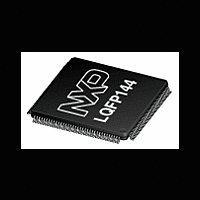LPC2917_19_01 NXP Semiconductors, LPC2917_19_01 Datasheet - Page 31

LPC2917_19_01
Manufacturer Part Number
LPC2917_19_01
Description
The LPC2917/2919/01 combine an ARM968E-S CPU core with two integrated TCMblocks operating at frequencies of up to 125 MHz, CAN and LIN, 56 kB SRAM, up to768 kB flash memory, external memory interface, two 10-bit ADCs, and multiple serial andparallel
Manufacturer
NXP Semiconductors
Datasheet
1.LPC2917_19_01.pdf
(86 pages)
- Current page: 31 of 86
- Download datasheet (555Kb)
NXP Semiconductors
LPC2917_19_01_3
Product data sheet
6.12.4.1 Pin description
6.12.4.2 Clock description
6.12.4 UARTs
6.12.5 Serial peripheral interface (SPI)
The LPC2917/2919/01 contains two identical UARTs located at different peripheral base
addresses. The key features are:
The UART is commonly used to implement a serial interface such as RS232. The
LPC2917/2919/01 contains two industry-standard 550 UARTs with 16-byte transmit and
receive FIFOs, but they can also be put into 450 mode without FIFOs.
The UART pins are combined with other functions on the port pins of the
LPC2917/2919/01.
Table 16.
The UART modules are clocked by two different clocks; CLK_SYS_PESS and
CLK_UARTx (x = 0-1), see
branch clock for power management. The frequency of all CLK_UARTx clocks is identical
since they are derived from the same base clock BASE_CLK_UART. The register
interface towards the system bus is clocked by CLK_SYS_PESS. The baud generator is
clocked by the CLK_UARTx.
The LPC2917/2919/01 contains three Serial Peripheral Interface modules (SPIs) to allow
synchronous serial communication with slave or master peripherals.
The key features are:
Symbol
UARTx TXD
UARTx RXD
•
•
•
•
•
•
•
•
•
•
•
•
16-byte receive and transmit FIFOs.
Register locations conform to 550 industry standard.
Receiver FIFO trigger points at 1 byte, 4 bytes, 8 bytes and 14 bytes.
Built-in baud rate generator.
Support for RS-485/9-bit mode allows both software address detection and automatic
address detection using 9-bit mode.
Master or slave operation
Each SPI supports up to four slaves in sequential multi-slave operation
Supports timer-triggered operation
Programmable clock bit rate and prescale based on SPI source clock
(BASE_SPI_CLK), independent of system clock
Separate transmit and receive FIFO memory buffers; 16 bits wide, 32 locations deep
Programmable choice of interface operation: Motorola SPI or Texas Instruments
Synchronous Serial Interfaces
Programmable data-frame size from 4 to 16 bits
UART pins
Pin name
TXDx
RXDx
Table 16
Rev. 03 — 9 December 2009
OUT
IN
Section
Direction
shows the UART pins (x runs from 0 to 1).
6.7.2. Note that each UART has its own CLK_UARTx
LPC2917/01; LPC2919/01
Description
UART channel x transmit data output
UART channel x receive data input
ARM9 microcontroller with CAN and LIN
© NXP B.V. 2009. All rights reserved.
31 of 86
Related parts for LPC2917_19_01
Image
Part Number
Description
Manufacturer
Datasheet
Request
R

Part Number:
Description:
ARM9 microcontroller with CAN and LIN
Manufacturer:
NXP [NXP Semiconductors]
Datasheet:
Part Number:
Description:
Arm9 Microcontroller With Can And Lin
Manufacturer:
NXP Semiconductors
Datasheet:
Part Number:
Description:
NXP Semiconductors designed the LPC2420/2460 microcontroller around a 16-bit/32-bitARM7TDMI-S CPU core with real-time debug interfaces that include both JTAG andembedded trace
Manufacturer:
NXP Semiconductors
Datasheet:

Part Number:
Description:
NXP Semiconductors designed the LPC2458 microcontroller around a 16-bit/32-bitARM7TDMI-S CPU core with real-time debug interfaces that include both JTAG andembedded trace
Manufacturer:
NXP Semiconductors
Datasheet:
Part Number:
Description:
NXP Semiconductors designed the LPC2468 microcontroller around a 16-bit/32-bitARM7TDMI-S CPU core with real-time debug interfaces that include both JTAG andembedded trace
Manufacturer:
NXP Semiconductors
Datasheet:
Part Number:
Description:
NXP Semiconductors designed the LPC2470 microcontroller, powered by theARM7TDMI-S core, to be a highly integrated microcontroller for a wide range ofapplications that require advanced communications and high quality graphic displays
Manufacturer:
NXP Semiconductors
Datasheet:
Part Number:
Description:
NXP Semiconductors designed the LPC2478 microcontroller, powered by theARM7TDMI-S core, to be a highly integrated microcontroller for a wide range ofapplications that require advanced communications and high quality graphic displays
Manufacturer:
NXP Semiconductors
Datasheet:
Part Number:
Description:
The Philips Semiconductors XA (eXtended Architecture) family of 16-bit single-chip microcontrollers is powerful enough to easily handle the requirements of high performance embedded applications, yet inexpensive enough to compete in the market for hi
Manufacturer:
NXP Semiconductors
Datasheet:

Part Number:
Description:
The Philips Semiconductors XA (eXtended Architecture) family of 16-bit single-chip microcontrollers is powerful enough to easily handle the requirements of high performance embedded applications, yet inexpensive enough to compete in the market for hi
Manufacturer:
NXP Semiconductors
Datasheet:
Part Number:
Description:
The XA-S3 device is a member of Philips Semiconductors? XA(eXtended Architecture) family of high performance 16-bitsingle-chip microcontrollers
Manufacturer:
NXP Semiconductors
Datasheet:

Part Number:
Description:
The NXP BlueStreak LH75401/LH75411 family consists of two low-cost 16/32-bit System-on-Chip (SoC) devices
Manufacturer:
NXP Semiconductors
Datasheet:

Part Number:
Description:
The NXP LPC3130/3131 combine an 180 MHz ARM926EJ-S CPU core, high-speed USB2
Manufacturer:
NXP Semiconductors
Datasheet:

Part Number:
Description:
The NXP LPC3141 combine a 270 MHz ARM926EJ-S CPU core, High-speed USB 2
Manufacturer:
NXP Semiconductors

Part Number:
Description:
The NXP LPC3143 combine a 270 MHz ARM926EJ-S CPU core, High-speed USB 2
Manufacturer:
NXP Semiconductors

Part Number:
Description:
The NXP LPC3152 combines an 180 MHz ARM926EJ-S CPU core, High-speed USB 2
Manufacturer:
NXP Semiconductors










